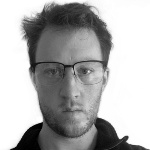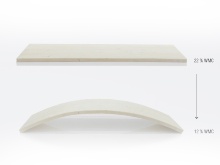Material Programming for Fabrication
Integrative Computational Design for Self-Shaping Curved Wood Building Components in Architecture
Form and structure play critical roles in architecture yet the processes required to produce performative geometries often require tremendous resources and physical effort. Advances in computational design and the programming of digital fabrication machines have increased variety, precision and automation in the production of building components. However, the underlying processes of generating material form still rely predominantly on brute force methods of shaping. This research presents an alternative, material programing approach for the fabrication of building components in which shape is generated by activating the material’s inherent capacity to change in relation to external stimuli. This concept is investigated through the development of an innovative method of self-shaping manufacturing for load-bearing curved wood building components. The dissertation introduces material programming in the context of architectural design, fabrication processes, wood materials, and existing self-shaping technology. The self-shaping method is investigated first through physical experiments and development of a computational design to fabrication approach. In parallel the challenges of upscaling and predictability are addressed through computational mechanics and physical prototyping. The concept is then adapted and implemented through the design and production of components for a building demonstrator highlighting both the technical efficiencies and architectural performance of the material system. The material programming approach is therefore shown as a simple yet sophisticated method of fabrication for a novel, ecological and effective architecture.
Completed disertation:
Wood, D.: 2021: Material programming for fabrication : integrative computational design for self-shaping curved wood building components in architecture. ICD Research Report No. 6, Universität Stuttgart, Stuttgart. (http://dx.doi.org/10.18419/opus-11968)
http://dx.doi.org/10.18419/opus-11968
PROJECT TEAM
ICD Institute for Computational Design and Construction, University of Stuttgart
Dylan Wood, Prof. A. Menges
Scientific Development
Dylan Wood
Scientific collaboration:
Laboratory of Cellulose and Wood Materials, Empa (Swiss Federal Laboratories for Materials Science and Technology), Switzerland & Wood Materials Science, ETH Zurich (Swiss Federal Institute of Technology Zurich), Switzerland
Dr. Markus Rüggeberg, Philippe Grönquist, Prof. I. Burgert
Self-forming Curved Wood Components Research and Development (PI)
Industry collaboration:
Blumer-Lehmann AG, Gossau, Switzerland
Katharina Lehmann, David Riggenbach
Self-forming Curved Wood Components Research and Development
Wood Manufacturing and Construction
PROJECT FUNDING
GETTYLAB
InnoSuisse - Swiss Innovation Agency
The Deutsche Bundesstiftung Umwelt DBU (German Federal Environmental Foundation)
University of Stuttgart
RELATED PUBLICATIONS
Wood, D., Grönquist, P., Bechert, S., Aldinger, L., Riggenbach, D., Lehmann, K., Rüggeberg, M., Burgert, I., Knippers, J., Menges, A.: 2020, From Machine Control to Material Programming: Self-Shaping Wood Manufacturing of a High Performance Curved CLT Structure -- Urbach Tower, in Burry, J., Sabin, J., Sheil, B., Skavara, M. (eds.), Fabricate 2020: Making Resilient Architecture, UCL Press, London, pp. 50-57. (ISBN: 978-1-78735-812-6)
Wood, D. , Correa, D., Krieg, O., Menges, A.: 2016. Material computation - 4D timber construction: towards building-scale hygroscopic actuated, self-constructing timber surfaces. International Journal of Architectural Computing (IJAC), Vol. 14(1), 49-62. DOI: 10.1177/1478077115625522
Grönquist, P., Wood, D., Hassani, M., Wittel, F., Menges, A., Rüggeberg, M.: 2019, Analysis of hygroscopic self-shaping wood at large scale for curved mass timber structures, Science Advances, Vol. 5 No. 9, pp. eaax1311. (doi:10.1126/sciadv.aax1311) URL
Wood, D., Vailati, C., Menges, A., Rüggeberg, M.: 2018, Hygroscopically actuated wood elements for weather responsive and self-forming building parts – Facilitating upscaling and complex shape changes, Construction and Building Materials, Volume 165, Elsevier. (DOI: 10.1016/S0950061817325394)
Wood, D., Brütting, J., Menges, A.: 2018, Self-Forming Curved Timber Plates: Initial Design Modeling for Shape-Changing Material Buildups, in IASS – Creativity in Structural Design [Proceedings of the IASS Symposium 2018], Boston.
Aldinger, L., Bechert, S., Wood, D., Knippers, J., Menges, A.: 2020, Design and Structural Modelling of Surface-Active Timber Structures Made from Curved CLT – Urbach Tower, Remstal Gartenschau 2019, in Gengnagel, C., Baverel, O., Burry, J., Ramsgaard Thomsen, M., Weinzierl, S. (Eds.), Impact: Design With All Senses [Proceedings of the Design Modelling Symposium 2019], Springer International Publishing, Cham, pp. 419-432. (doi: 10.1007/978-3-030-29829-6 33)
Contact Information

Dylan Wood
Dr. -Ing. M.Sc. BArchFormer Research Group Leader | Material Programming


